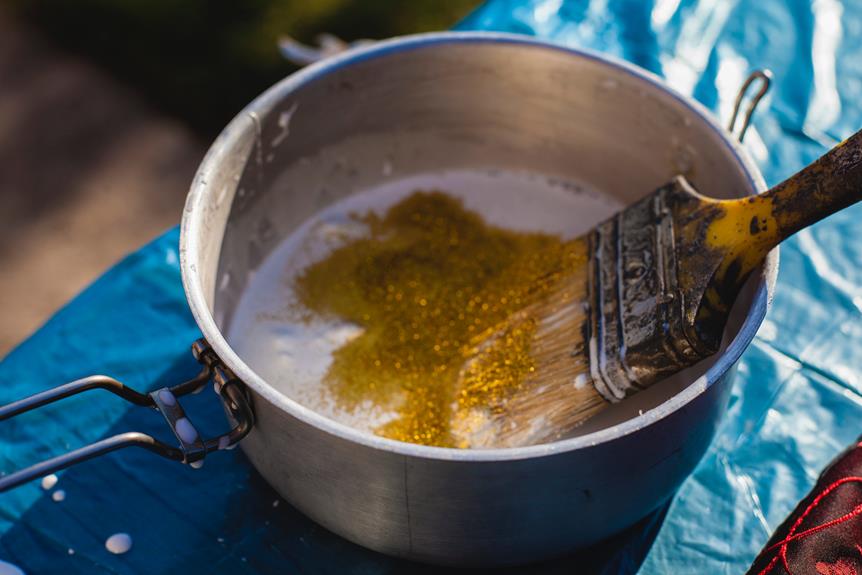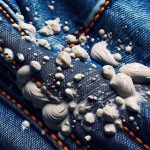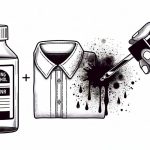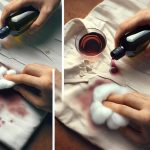Hey there!
Dealing with hot glue on fabrics can feel like trying to untangle a knotted necklace – frustrating and time-consuming. But fear not! You're about to master five effective methods to undo that pesky hot glue and restore your fabrics to their former glory.
From freezing to ironing, vinegar to rubbing alcohol, and Goo Gone, these techniques will have you feeling like a fabric magician. So, grab your materials and get ready to tackle this challenge head-on.
With these tricks up your sleeve, you'll be a pro at removing hot glue from fabrics in no time.
Let's dive in and reclaim those pristine fabrics!
Key Takeaways
- Freezing the hot glue can make it easier to remove by hardening it and then scraping it off with a dull knife or credit card.
- The ironing technique involves using a low heat setting and a piece of paper towel to gently iron over the hot glue, softening it without damaging the fabric.
- A vinegar solution can be used to break down the hot glue by applying it with a soft-bristled brush and scrubbing in circular motions.
- Rubbing alcohol can be effective in loosening hot glue stains by dabbing it onto the fabric and gently blotting, followed by rinsing with cold water and air drying.
Freezing Method
To remove hot glue from fabrics using the freezing method, place the affected area in a plastic bag and freeze it for at least an hour. This method is quite effective in hardening the glue, making it easier to scrape off. Once the glue is frozen, take the fabric out of the freezer and carefully peel or scrape off the hardened glue using a dull knife or a credit card. Be gentle to avoid damaging the fabric.
Using heat is another effective way to remove hot glue from fabrics. By using a hairdryer or an iron on a low setting, you can soften the glue, making it easier to remove. Simply aim the hairdryer at the affected area to warm up the glue, then scrape it off with a dull knife or credit card. When using an iron, place a piece of parchment paper over the affected area and gently iron over it. The heat will soften the glue, allowing you to peel it off.
As a last resort, using chemicals like rubbing alcohol or acetone can help dissolve hot glue. However, be cautious when using these chemicals, as they can affect certain types of fabrics. Always test on a small, inconspicuous area first to ensure it won't cause damage.
Ironing Technique
You can use the ironing technique to soften hot glue on fabrics, making it easier to remove. To begin, place a piece of paper towel over the affected area to protect the fabric.
Then, set your iron to a low heat setting. Gently iron over the paper towel, moving the iron in circular motions for about 20-30 seconds. This will help to soften the hot glue without damaging the fabric.
When using the ironing technique, it's important to remember a few fabric care tips. Always test the iron on a small, inconspicuous area of the fabric first to ensure that the heat doesn't cause any damage. Additionally, be cautious not to leave the iron in one spot for too long, as this can lead to scorching or burning of the fabric.
If the hot glue has hardened deeply into the fabric, you may need to repeat the process multiple times, using fresh paper towels each time. Once the hot glue has softened, carefully peel it off the fabric using a pair of tweezers or your fingers. Be gentle to avoid damaging the fabric.
Vinegar Solution
Using a soft-bristled brush, gently apply the vinegar solution to the hot glue affected area, frequently scrubbing in circular motions. Vinegar is a versatile and effective solution for removing hot glue from fabrics. Its acidic nature helps to break down the glue without causing damage to the fabric. Mix equal parts of white vinegar and water to create the solution. Dab a small amount of the solution onto the affected area, then gently scrub with the brush. Continue this process until the hot glue begins to loosen and lift from the fabric fibers.
When using the vinegar solution, it's essential to test it on a small, inconspicuous area of the fabric first to ensure it doesn't cause any discoloration or damage. Additionally, always wash the fabric thoroughly after using the vinegar solution to remove any residual odor.
While the vinegar solution is an effective method for removing hot glue from fabrics, there are alternative methods such as using rubbing alcohol or freezing the hot glue to make it brittle and easier to remove. When dealing with fabrics, it's crucial to prioritize preventing damage and practicing proper fabric care throughout the removal process.
Rubbing Alcohol
How effectively can rubbing alcohol remove hot glue from fabrics?
Rubbing alcohol can be a lifesaver when it comes to removing stains, especially hot glue, from different fabric types. Here are some tips to make the most of this method:
- Spot Test: Before applying rubbing alcohol to the entire stained area, it's crucial to conduct a spot test on a small, inconspicuous part of the fabric. This helps ensure that the alcohol won't cause any damage or discoloration.
- Blotting Technique: Pour a small amount of rubbing alcohol onto a clean cloth and gently dab at the hot glue stain. Avoid rubbing vigorously, as this could spread the glue further into the fabric fibers.
- Rinsing with Water: After the rubbing alcohol has effectively loosened the hot glue, rinse the fabric with cold water. This helps to remove any remaining residue and alcohol from the fabric.
- Air Dry: Allow the fabric to air dry completely before checking to ensure the hot glue stain has been thoroughly removed.
Goo Gone Application
Applying Goo Gone directly to the hot glue stain on the fabric can effectively help dissolve and remove the adhesive residue. Before using Goo Gone, it's essential to pre-treat the fabric by testing it in an inconspicuous area to ensure that it won't cause any damage or discoloration.
Once you've confirmed that it's safe to use, apply a small amount of Goo Gone onto the hot glue stain and let it sit for a few minutes to penetrate the adhesive. After allowing it to soak, gently rub the fabric together to help loosen the glue. You can also use a soft-bristled brush to work the Goo Gone into the fabric fibers for better penetration.
However, it's important to keep in mind that Goo Gone may not be suitable for all fabric types, so it's advisable to consider alternative methods if the fabric is delicate or sensitive. After the adhesive residue has been loosened, wash the fabric according to the manufacturer's instructions to remove any remaining Goo Gone and hot glue residue.
Frequently Asked Questions
Can Hot Glue Be Removed From Delicate Fabrics Like Silk or Lace Using Any of These Methods?
You can remove stubborn hot glue from delicate fabrics like silk or lace using a gentle approach. Use fabric care guidelines and try methods like freezing, rubbing alcohol, or vinegar to dissolve the glue without damaging the fabric.
Is There a Risk of Damaging the Fabric When Using the Freezing Method to Remove Hot Glue?
When using the freezing method to remove hot glue, it's essential to do a risk assessment first. While it's generally safe for most fabrics, there's a possibility of damaging delicate ones. Always prioritize fabric preservation.
Will the Vinegar Solution Leave a Strong Odor on the Fabric After Use?
After using the vinegar solution to remove hot glue, you might notice a slight odor, but it should dissipate with airing out. Delicate fabrics may require extra care, but the solution can effectively remove hot glue without leaving a lasting scent.
Can Rubbing Alcohol Be Used on All Types of Fabrics, or Are There Some That It May Damage?
Rubbing alcohol is effective for removing hot glue from most fabrics. However, it's important to test a small, hidden area first to ensure it won't damage the fabric. If concerned, consider alternative methods like using heat or adhesive removers.
Are There Any Precautions to Take When Using Goo Gone on Fabrics, Such as Potential Discoloration or Staining?
When using Goo Gone on fabrics, take precautions for potential staining and ensure fabric compatibility. Always spot test in an inconspicuous area first. Avoid prolonged contact and thoroughly wash the fabric after using Goo Gone.
- Cotton Gabardine Fabric: A Durable and Versatile Wardrobe Staple - June 23, 2025
- The 1950s Gabardine Jacket: A Rockabilly and Vintage Style Essential - June 23, 2025
- A Buyer’s Guide to Women’s Wool Gabardine Pants - June 23, 2025







